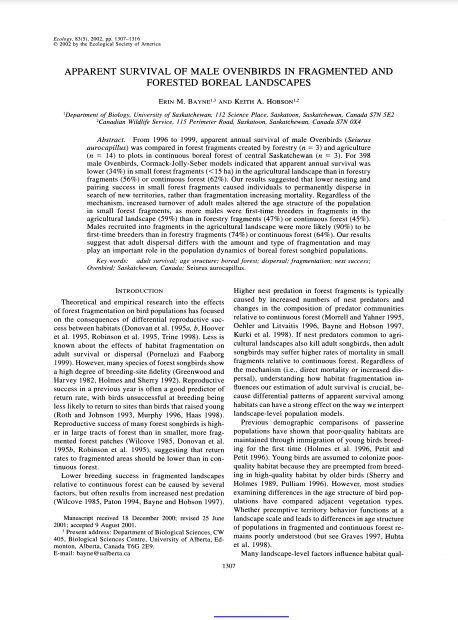Apparent Survival of Male Ovenbirds in Fragmented and Forested Boreal Landscapes
Bosque Modelo:
Prince Albert
Temática:
Conservación
Tipo de documento:
Artículo científico
Resumen
From 1996 to 1999, apparent annual survival of male Ovenbirds (Seiurus aurocapillus) was compared in forest fragments created by forestry (n = 3) and agriculture (n = 14) to plots in continuous boreal forest of central Saskatchewan (n = 3). For 398 male Ovenbirds, Cormack-Jolly-Seber models indicated that apparent annual survival was lower (34%) in small forest fragments (< 15 ha) in the agricultural landscape than in forestry fragments (56%) or continuous forest (62%). Our results suggested that lower nesting and pairing success in small forest fragments caused individuals to permanently disperse in search of new territories, rather than fragmentation increasing mortality. Regardless of the mechanism, increased turnover of adult males altered the age structure of the population in small forest fragments, as more males were first-time breeders in fragments in the agricultural landscape (59%) than in forestry fragments (47%) or continuous forest (45%). Males recruited into fragments in the agricultural landscape were more likely (90%) to be first-time breeders than in forestry fragments (74%) or continuous forest (64%). Our results suggest that adult dispersal differs with the amount and type of fragmentation and may play an important role in the population dynamics of boreal forest songbird populations.
Información Bibliográfica
Autor:
Bayne, EM and KA Hobson.
Revista:
Ecology
Año:
2002
N°:
5
País :
Canadá
Páginas:
1307 - 1316
Volumen:
83
Idioma:
Ingles
Palabras claves
adult survival; age structure; boreal forest; dispersal; fragmentation; nest success; Ovenbird; Saskatchewan, Canada; Seiurus aurocapillus.





